Mid-season cucumber "Rodnichok" pollinated by bees from Moldovan breeders
The Rodnichok hybrid was bred more than 40 years ago, but is still one of the most demanded crops on the domestic market. Breeders annually create dozens of new varieties and hybrids, but Rodnichok is in no way inferior in characteristics and properties.
The content of the article
Description of the hybrid
Cucumber Rodnichok was registered in the State Register of the Russian Federation in 1979, although the application was filed several years earlier. This hybrid has a strong immunity to powdery mildew and other dangerous diseases of the pumpkin family.
For reference... The hybrid is successfully grown in open ground, in a greenhouse and under a film shelter throughout Russia.
Distinctive features
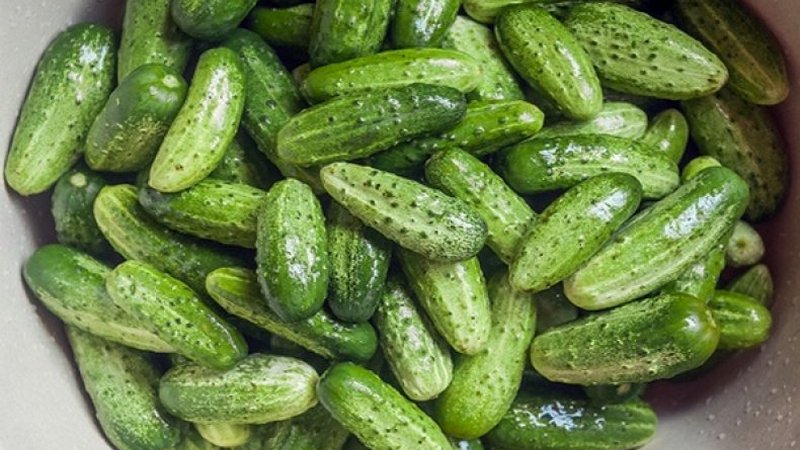
The main stem of the bush reaches a length of 3 m, while the lateral shoots are poorly developed. For the entire growing season, 4-5 lashes are formed. Each node forms 2-3 flowers (mainly of the female type), from which the fruits are formed. The fontanelle, like most cucumbers, has a weak root system.
Composition, properties, benefits, calories
Nutritional value per 100 g is:
- proteins 0.9 g;
- carbohydrates 2.7 g;
- fats 0.1 g;
- fiber 0.7 g;
- a small amount of vitamins C, PP, E and group B;
- 95-98% water, which quenches thirst and cleanses the body of toxic substances.
The total calorie content of fresh cucumbers per 100 g is only 16 kcal.
Cucumber juice contains natural organic acids in its composition and has amazing properties:
- removes salts from the body and joints;
- washes away free radicals;
- removes cholesterol plaques from blood vessels;
- dissolves sand and kidney stones;
- improves blood properties.
Cucumbers are a refreshing, nutritious and versatile addition to any diet.
Specifications
The fontanelle produces beautiful fruits of light green color with white stripes on the sides and rare black thorns... The length of the cylindrical zelents is 9-12 cm, the weight is 90-100 g. Even fruits have an excellent presentation, which allows farmers to successfully sell these vegetables.
Bitterness the taste is absent, the pulp is juicy and crispy. The seeds in vegetables are small, practically not felt, the shell is thin, but strong. The fruits are stored for a long time and tolerate transportation well without losing their external and taste characteristics.
Fruiting is extended, vegetables ripen 50-55 days after germination. In the south of the country, the first cucumbers are harvested at the end of June, in other regions - at the beginning of July.
If you follow agrotechnical rules, the plants will give a rich harvest. When growing cucumbers, Spring in the open field from 1 sq. m, vegetable growers collect 5-7 kg of the crop, and with the growth of the crop in greenhouse conditions - up to 17 kg.
Important! Cucumber The fontanelle is a hybrid type of plant, but the crop is pollinated by insects.
How to grow yourself
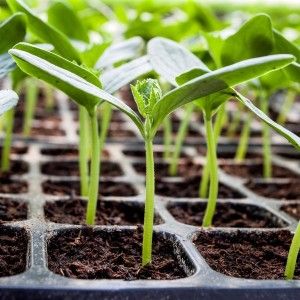
The time of sowing seeds in the ground or for seedlings depends on the method of cultivation (in open or closed ground), the climate of the area, the weather.
In the middle zone of the Russian Federation, seed material or seedlings are planted on an open bed in early June. In the greenhouse, seedlings of cucumbers are planted two weeks earlier.
Sowing seeds for seedlings is carried out two months before these dates (around the beginning of May). The soil temperature for planting plants should be at least + 16 ... + 18 ° С in protected or closed ground.
In the southern regions, sowing seeds directly into the ground is carried out in early to mid-April. For this, the soil must warm up to at least +14 ° C.
Important! Seeds are not planted before the onset of heat - the grains will simply die without germinating.
If the weather is changeable, seeds are planted at several times, but no later than mid-summer. Fruiting in this case will be stretched.
Seedling planting
For an earlier harvest, cucumbers are grown in seedlings, but some growers plant seeds directly in the beds.
Cucumber seedlings need a fertile and neutral soil. Farmers purchase potting mix from a gardening store or prepare their own by mixing humus, turf, and manure in a 7: 1: 2 ratio.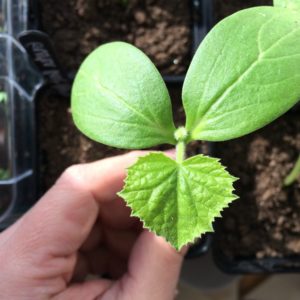
Seed material is disinfected before planting in a 1% solution of potassium permanganate (if the grains were not pickled by the manufacturer), then washed under running water.
Then the seeds are germinated in a damp cotton cloth until seed-sized sprouts appear. The gauze is periodically moistened, but the seeds are not allowed to float in the water. This procedure is carried out to ensure the germination of seeds and to obtain early shoots.
When the grains hatch, they are planted in individual containers for 1-2 seeds to a depth of 1.5-2 cm. After a while, the weak sprout is removed. A container for growing seedlings is chosen with a volume of at least 0.4-0.5 liters. In it, it will grow until disembarkation. Picking is not recommended.
The container with crops is placed in a warm place with an air temperature of + 20 ... + 25 ° C and covered with a film or transparent glass to create greenhouse conditions. When shoots appear, the container is transferred to a cooler place with an air temperature of + 20 ... + 22 ° С during the day, and + 15 ... + 16 ° С at night. Water the seedlings in the morning with water at room temperature.
After 20-25 days, the plants are planted in a permanent place. Overgrown seedlings, it will be worse to take root in a new place. A week before planting, the plants are hardened. To do this, the bushes are taken out onto the balcony or placed near an open window, but so that there is no draft.
Direct sowing in the ground
The place for growing cucumbers is chosen sunny and calm. The plot should be free of stagnant water in rainy weather, as this causes fungal diseases, which significantly reduces the yield.
In hot southern regions, planting is allowed in partial shade. For the cultivation of cucumbers, the rules of crop rotation are observed. Zelentsy is not re-grown in the same place or after melons. Good predecessors are tomato, peas, potatoes and corn.
Cucumber soil should be light and nutritious... The soil is prepared in the fall or two weeks before planting. To do this, organic matter is introduced into it (turf, peat, compost, manure, humus). Wood ash and mineral fertilizers, for example, "Superphosphate", are also added to the soil.
On a note. For confidence, many vegetable growers disinfect the soil with a solution of copper sulfate (1 tsp for 10 liters of water).
Further care of plants
The cultivation of a cucumber crop requires the implementation of agrotechnical rules. Vegetable growers conduct regular watering, apply fertilizers, remove weeds, take preventive measures against diseases and pests... When the first symptoms are detected, folk or traditional remedies are used.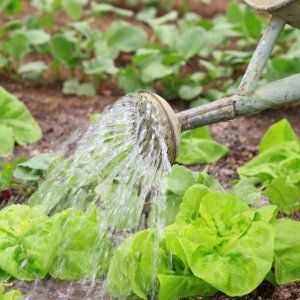
In the open ground near the beds, grooves are dug. Moistening is carried out with warm water in prepared trenches. The soil is moistened as it dries. Indoors, plants are watered regularly. For this, 1 sq. m use 4-5 liters of water at room temperature. The soil is kept moist so that air permeability is not impaired.
When buds appear, the culture is watered once every 2-3 days. The amount of water per square meter is increased by 5 liters. Ovaries form after flowering. Moisturizing plants during this period is carried out every other day.After watering, the soil around the bushes is loosened and at the same time weeds are removed.
On a note. In hot weather, the glass of the greenhouse is watered with a solution of chalk so that the culture does not get burned and does not fade.
When 3-4 leaves appear in the bushes, the plants are fertilized with organic matter. Further cucumbers feed every 15 days with complex fertilizers. To do this, use special drugs, for example, "Good Power". The f1 fontanel responds well to nettle or yeast infusion. During the formation of ovaries, fertilizers with potassium and phosphorus are added.
When the crop begins to bear fruit, the plants are fed with infusion of green grass or mineral fertilizers.
Features of cultivation and possible difficulties
Fontanelle formed only when grown on a trellis... The main shoot is pinched when it reaches the top row, and the lateral branches are above the third node. Otherwise, the cultivation of this hybrid is no different from the cultivation of other cucumbers.
Typical diseases and pests
The hybrid has strong immunity to diseases and pests. The appearance of many diseases and hostile insects is most often associated with mistakes in care.
Low temperature, high humidity and stuffiness in the greenhouse, watering the crop with cold water, temperature drops, violation of crop rotation - all this negatively affects the growth and development of cucumbers and leads to the appearance of pathogenic fungi and bacteria. To prevent such troubles, vegetable growers must perform the following preventive measures:
- Before planting, the seeds are disinfected.

- Observe the rules of crop rotation.
- When growing a cucumber crop in greenhouse conditions, the soil is disinfected once a year and the top layer of the earth is changed every two years.
- In the fall, after harvesting, they get rid of the remains of crops and weeds.
- Disinfecting the greenhouse structure and inventory.
- Make sure that the soil contains microorganisms that suppress the development of pathogens. To do this, organic fertilizers are applied in the form of humus, compost, and the soil is sprayed with a useful infusion of nettle.
- Water the plants with settled or rainwater at room temperature, avoiding stagnation of water.
- Be sure to tie up cucumber shoots.
When the first signs of disease or insect pests appear, the bushes are treated. Bordeaux mixture is used against most fungal diseases. Pests are destroyed with folk remedies. To do this, use garlic or tobacco infusion, sprinkle the plants and the soil around them with wood ash. Marigolds, calendula or mint are also planted next to cucumbers. The pungent smell repels insects.
Harvesting and application of the crop
Fruiting of cucumber culture is extended. It begins in about 50 days. Harvesting is carried out every 2 days.
Cucumbers make delicious summer salads, winter storage and salting.
Advantages and disadvantages
The cucumber Rodnichok f1 is liked by summer residents for its many positive qualities. The benefits of this hybrid include: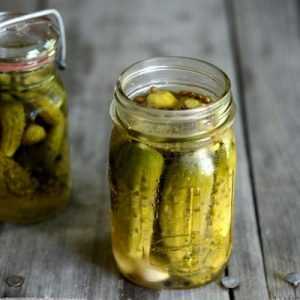
- strong immunity to diseases and pests;
- planting and leaving does not require much effort;
- long-term fruiting;
- the culture grows well both in the greenhouse and in the open field, even in small shades;
- high productivity;
- versatility of vegetables;
- excellent taste;
- attractive presentation;
- transportability and long-term storage without loss of external and taste characteristics.
The hybrid has very few disadvantages. These include:
- decrease in yield indicators in the open field;
- the need for pollination;
- the inability to use seeds from their own harvest, since this is a hybrid, not a variety.
The fontanelle has more positive qualities than disadvantages, which is why many vegetable growers prefer this particular hybrid.
Reviews
Experienced summer residents appreciate the Spring from the positive side. Cucumbers are actively grown in the vast majority of regions of the country.
Svetlana, Saratov: "I have been doing vegetable growing for a long time. I always grow new varieties and hybrids for myself. Last year I tried to plant the Rodnichok cucumber. The fruits grow beautiful, as in the photo of the package with seeds, long and weighty, and most importantly, delicious. I fed the culture, as they say, "from the heart", as a result there was so much harvest that I did not know what to do with it. She treated her relatives and neighbors to vegetables. Probably, this hybrid is the right thing to implement ”.
Vasily, Cheboksary: “I have been growing hybrid cucumbers for 7 years. Most of all I liked the Spring f1. To obtain a bountiful harvest, he looked after the plants daily. The main thing is to ensure that the plants have enough moisture. Otherwise, the vegetables may become bitter. I grow the culture in greenhouse conditions. The fontanelle practically does not get sick. The fruits are delicious. In general, I like the hybrid and will continue to grow it. "
Conclusion
The spring has gained great popularity among vegetable growers. The crop has a strong immunity to most diseases, making it much easier to grow these vegetables. The hybrid is cultivated both indoors and outdoors. The fruits have excellent taste and presentation, which makes it possible to use cucumbers for sale. The fontanel does not require special attention in care - even a novice gardener can cope with its cultivation.
You will learn more information about the Rodnichok hybrid in the following video: